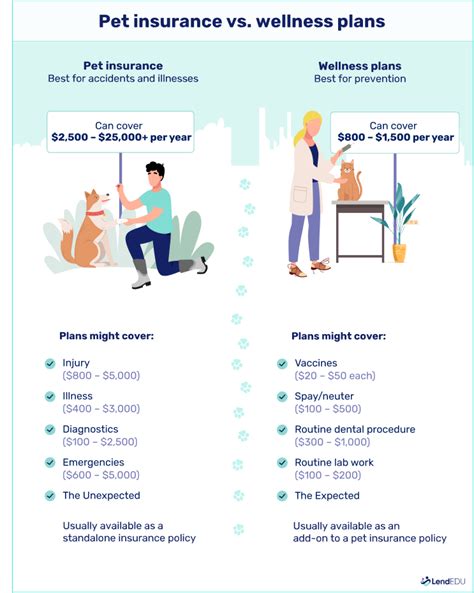Introduction

Protecting your furry friend’s health and well-being is essential. However, deciding between pet insurance and wellness plans can be overwhelming. This comprehensive review provides insights into both options, guiding you toward the best choice for your pet’s needs.
Pet Insurance vs. Wellness Plans: Key Differences
Coverage
- Pet Insurance: Covers unexpected veterinary expenses such as accidents, illnesses, and surgeries.
- Wellness Plans: Focuses on preventive care, including vaccinations, checkups, and routine treatments.
Cost
- Pet Insurance: Premiums vary based on factors such as breed, age, location, and coverage selected. Premiums typically range from $20 to $100 per month.
- Wellness Plans: Monthly fees cover a set package of preventive care services, with fees typically ranging from $40 to $80 per month.
Deductible
- Pet Insurance: Usually involves an annual deductible that must be met before coverage applies. Deductibles can range from $100 to $1000.
- Wellness Plans: No deductible is required.
Reimbursement
- Pet Insurance: Claims are submitted to the insurance company, which reimburses a percentage of covered expenses.
- Wellness Plans: No reimbursement occurs as expenses are covered by the plan’s monthly fee.
Pros and Cons of Pet Insurance
Pros:
- Peace of mind knowing your pet is covered for unexpected veterinary costs.
- Prevents financial hardship resulting from expensive medical treatments.
- May offer coverage for alternative therapies and behavioral issues.
Cons:
- Premiums can be higher for older, high-risk pets.
- Deductibles and co-pays can reduce coverage benefits.
- Exclusions and limitations may apply to certain conditions or treatments.
Pros and Cons of Wellness Plans
Pros:
- Predictable and affordable coverage for routine care.
- Promotes proactive pet health by encouraging regular checkups and preventive treatments.
- May save money in the long run by preventing costly illnesses.
Cons:
- Does not cover unexpected veterinary expenses.
- May not be cost-effective for pets with few health problems.
- Some plans may have limited coverage or restrictions on certain services.
Choosing the Best Option for Your Pet
Consider the following factors when making a decision:
- Pet’s Age and Health: Older pets may benefit more from pet insurance, while younger pets with good health may find wellness plans sufficient.
- Financial Situation: Pet insurance offers peace of mind but can be expensive. Wellness plans provide a more affordable option for basic care.
- Lifestyle: If your pet is prone to accidents or illnesses, pet insurance may be a wiser choice. For pets with a low risk of major health issues, a wellness plan may suffice.
Tips and Tricks
- Shop around for both pet insurance and wellness plans: Compare coverage, premiums, and deductibles to find the best deal.
- Read reviews and get recommendations: Get insights from other pet owners who have used these services.
- Consider a combination of insurance and a wellness plan: This provides comprehensive protection for your pet’s health and well-being.
- Negotiate with your veterinarian: Ask about discounts for multiple pets or preventive care packages.
Why Wellness Matters
Preventive care is crucial for maintaining your pet’s health and reducing the risk of costly illnesses. Wellness plans help ensure your pet receives regular checkups, vaccinations, and dental care.
Benefits of Pet Insurance
Pet insurance provides peace of mind and financial protection against unexpected veterinary expenses. It can help you afford life-saving treatments, surgery, and medications.
Market Insights
According to the American Pet Products Association, 56% of U.S. households own a pet. By 2025, the pet insurance market is projected to reach $3.5 billion, with wellness plans experiencing significant growth.
Future Trends
- Telemedicine for pets: Virtual veterinary consultations offer convenience and accessibility.
- Artificial intelligence (AI) in pet care: AI-powered devices can monitor pet health and provide early detection of health issues.
- Personalized pet care plans: Data-driven tools help tailor care plans based on individual pet needs.
Conclusion
Pet insurance and wellness plans provide different approaches to protecting your pet’s
health.
-
Pet insurance: Coverage for unexpected veterinary expenses
-
Wellness plans: Preventive care for routine checkups and treatments
By carefully weighing the pros, cons, and your pet’s individual needs, you can make an informed decision that ensures optimal health and well-being for your furry companion.





















